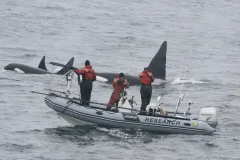Listening for Clues About Sonar’s Effects on Marine Mammals

Many animals depend on their eyes to navigate, find food, locate mates, and for other important activities. But marine mammals often rely on sound—sometimes far more than sight—for such critical daily tasks. Increasingly though, boat traffic, energy extraction, and other noisy human activities echo through the marine realm sometimes disrupting these animals’ behavior.
Six years ago, a group of marine scientists, acousticians (experts in sound), and U.S. government and Navy personnel met to discuss how one of these noisy activities—military sonar—affects marine mammals. It was clear that in some places, sonar had caused groups of animals to strand on the beach. These unintended outcomes of a small number of training exercises shared some commonalities: they tended to happen in canyon-like environments where sounds would bounce around and often affected certain deep-diving species known as beaked whales. Other than these clues, however, we knew almost nothing about what caused these stranding events or generally how marine mammals react to these kinds of sonar sounds.
To get answers, NOAA, the U.S. Navy, and marine scientists from other institutions formed a research partnership. We decided to use modern tools (like tracking tags and listening sensors) and established methods called “controlled exposure experiments” (CEEs) to begin piecing together the puzzle.
As the head of NOAA’s Ocean Acoustics Program at the time, I was thrust into the action. Up to that point, most of my research had been with seals in the lab and on the beach, not beaked whales at sea; I was ecstatic to be involved, but apprehensive.
Two years later, we were bobbing around the Bahamas on a Navy training range using their remarkable listening array to find beaked whales and monitor their movements. Despite their shy, elusive nature, we managed to find and tag the whales with suction-cup listening devices. We prepared to play simulated sonar sounds back to them and monitor their reactions. I knew these were critical data that could help reduce future stranding, but I admit I was slightly concerned, given the previous strandings with similar sounds. But knowing that we had extensive safety protocols in place and that these whales regularly cruised this active training range without stranding made me confident we could complete the experiments without harming them. But I sure was glad when we managed to do so—and get back some interesting results about behavioral responses. As expected, beaked whales seemed much more responsive than other species, like pilot whales.
After two years in the Bahamas, and another in the Mediterranean Sea, we had learned a fair amount but wanted to work where we could safely test other species like large whales and seals that had not shown strong responses to military sonar sounds before despite encountering them often. We also wanted to be able to test perhaps the most sensitive species, Cuvier’s beaked whales. We moved the project to southern California, connecting it with several other ongoing and successful field studies, and dubbed it SOCAL-10.
During the summer of 2010, SOCAL-10 researchers worked in coastal areas from San Diego to the northern Channel Islands, and in offshore areas like the U.S. Navy’s training range near San Clemente Island. We monitored 21 species of whales, dolphins, seals, and sea lions, nine of which were tagged and tracked—including elusive Cuvier’s beaked whales.
While conclusions are preliminary, we found some interesting things. The beaked whale responses were similar to our earlier measurements in the Bahamas, suggesting that these species are particularly sensitive. In other species, like blue whales, we found little to no observable reactions in some cases, but saw temporary avoidance behavior in others. The primary difference seemed to be what the animals were doing at the time the tests were conducted.
There are certainly more pieces to the puzzle, including more data to be analyzed from the SOCAL-10 effort, but these early findings put us on the path toward better understanding the effects of sonar on marine mammals. Our findings are providing greater insight into the basic understanding of these amazing animals and will have important implications for the conservation management of marine mammals, both generally and particularly regarding human sound in the ocean.
Editor’s Note: Our guest blogger, Dr. Brandon Southall, is President and Senior Scientist for Southall Environmental Associates, Inc. and a Research Associate with the University of California, Santa Cruz. He discussed recent findings from the SOCAL-10 project Thursday, January 6, 2011 at Smithsonian’s National Museum of Natural History. Watch the video of his presentation, "New Findings on the Effects of Noise on Whale and Dolphin Behavior."

